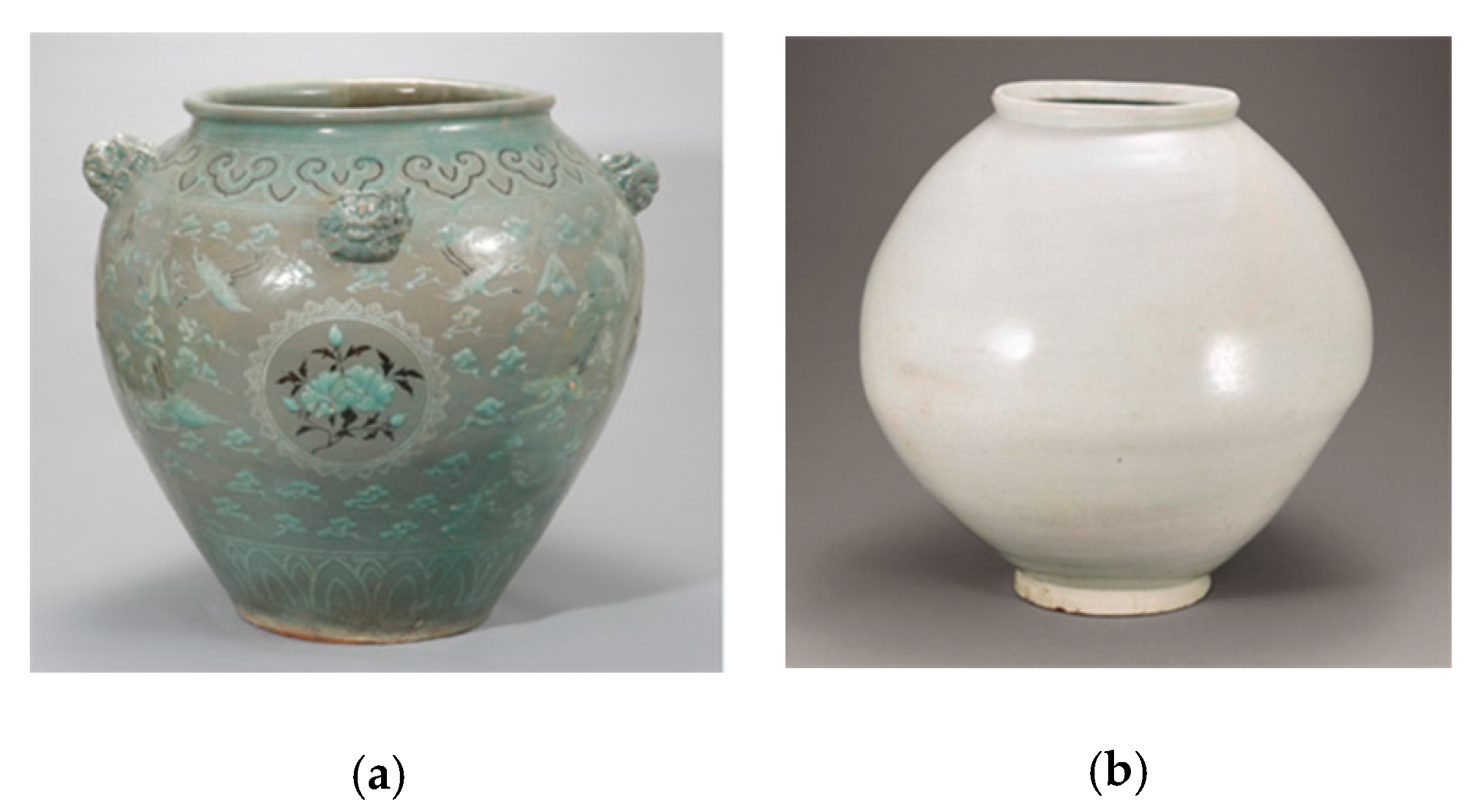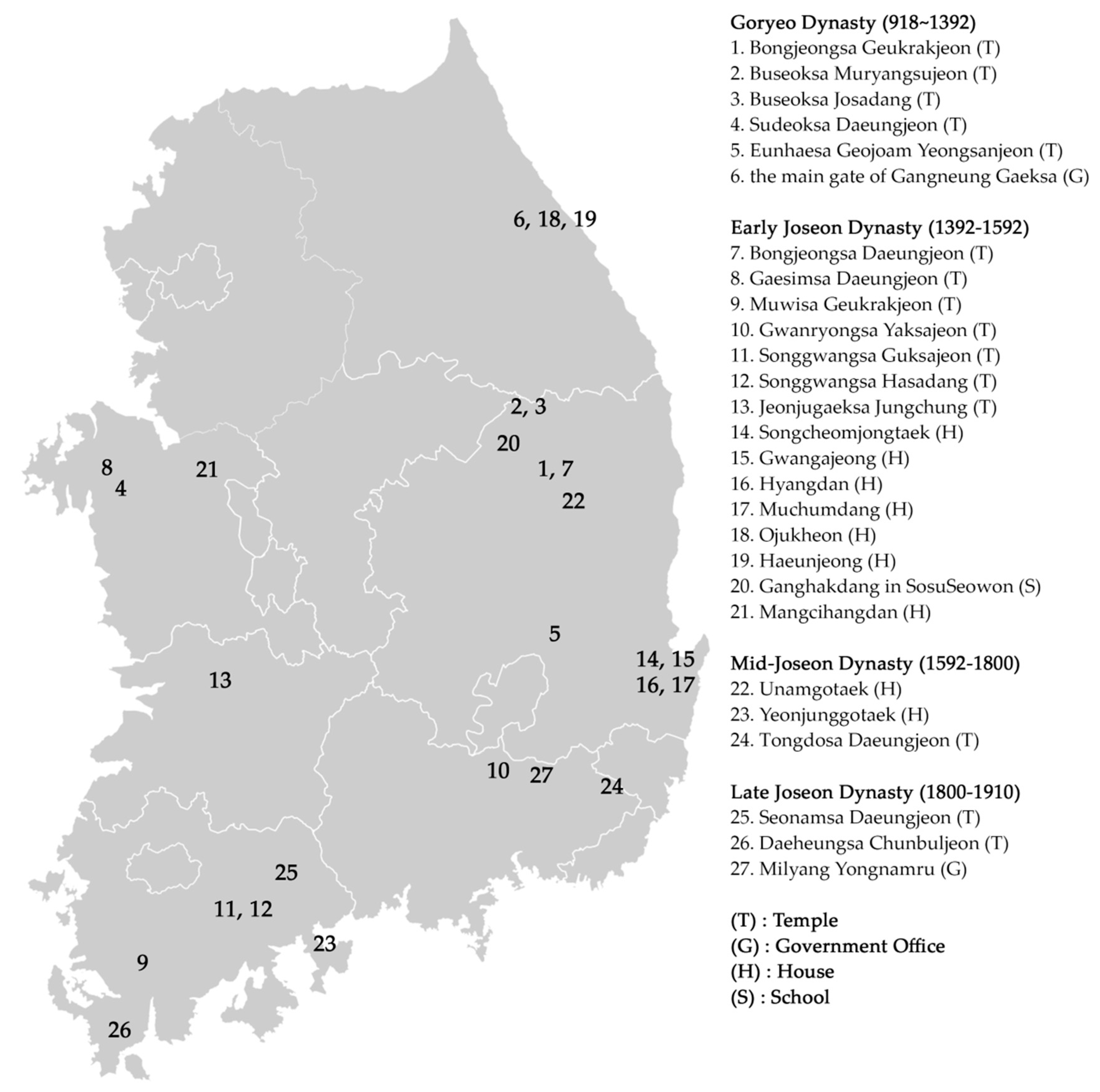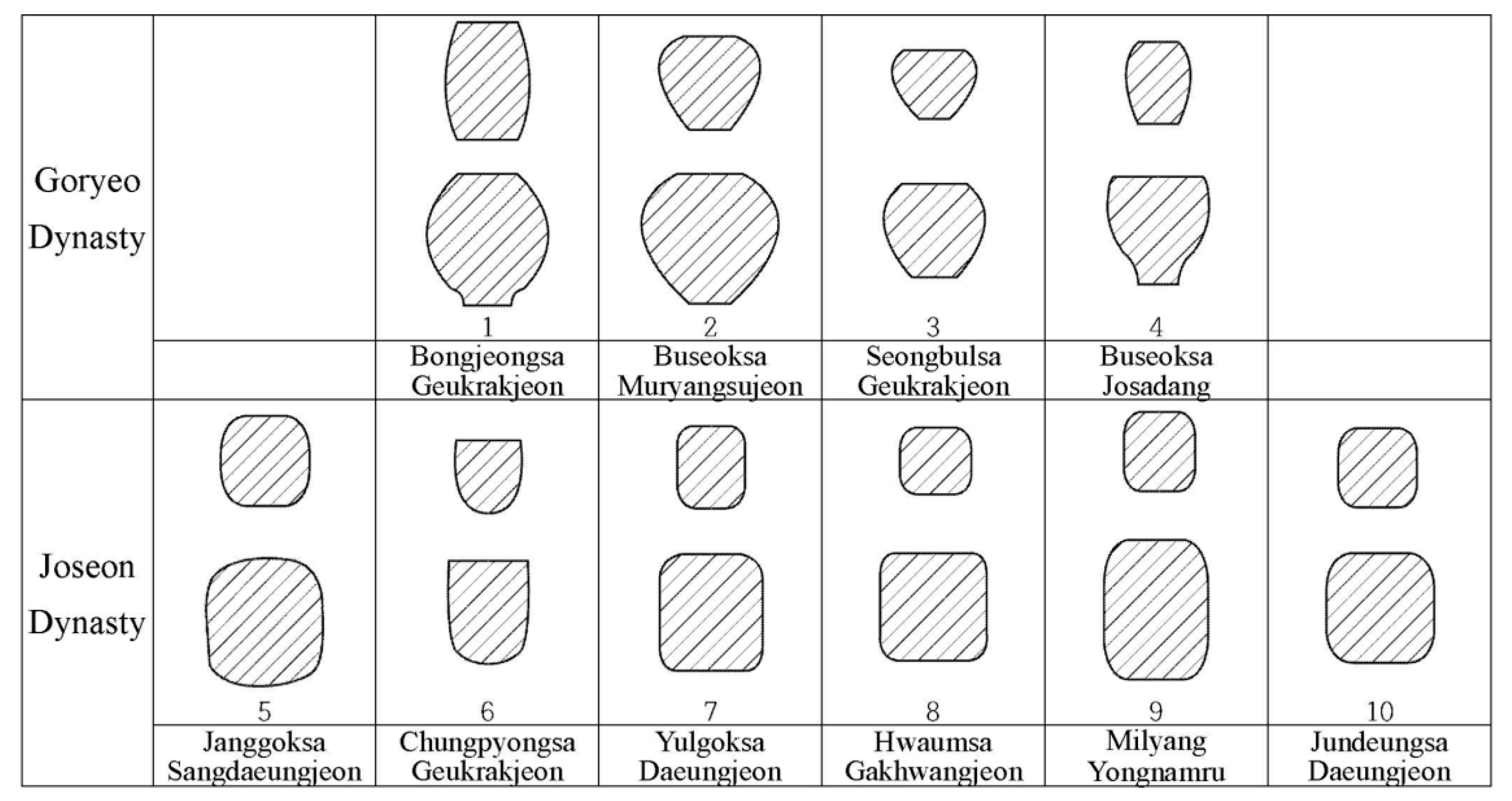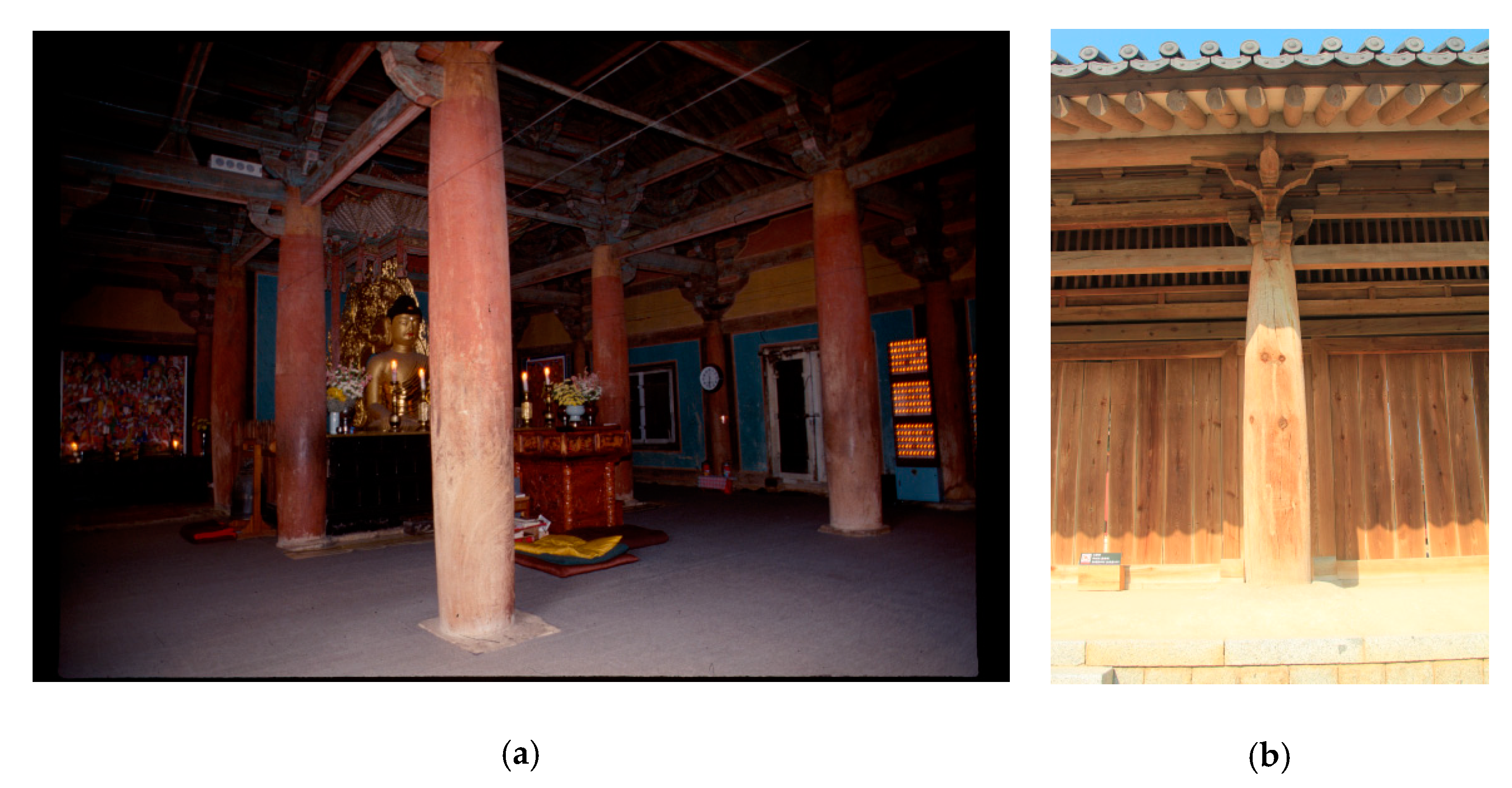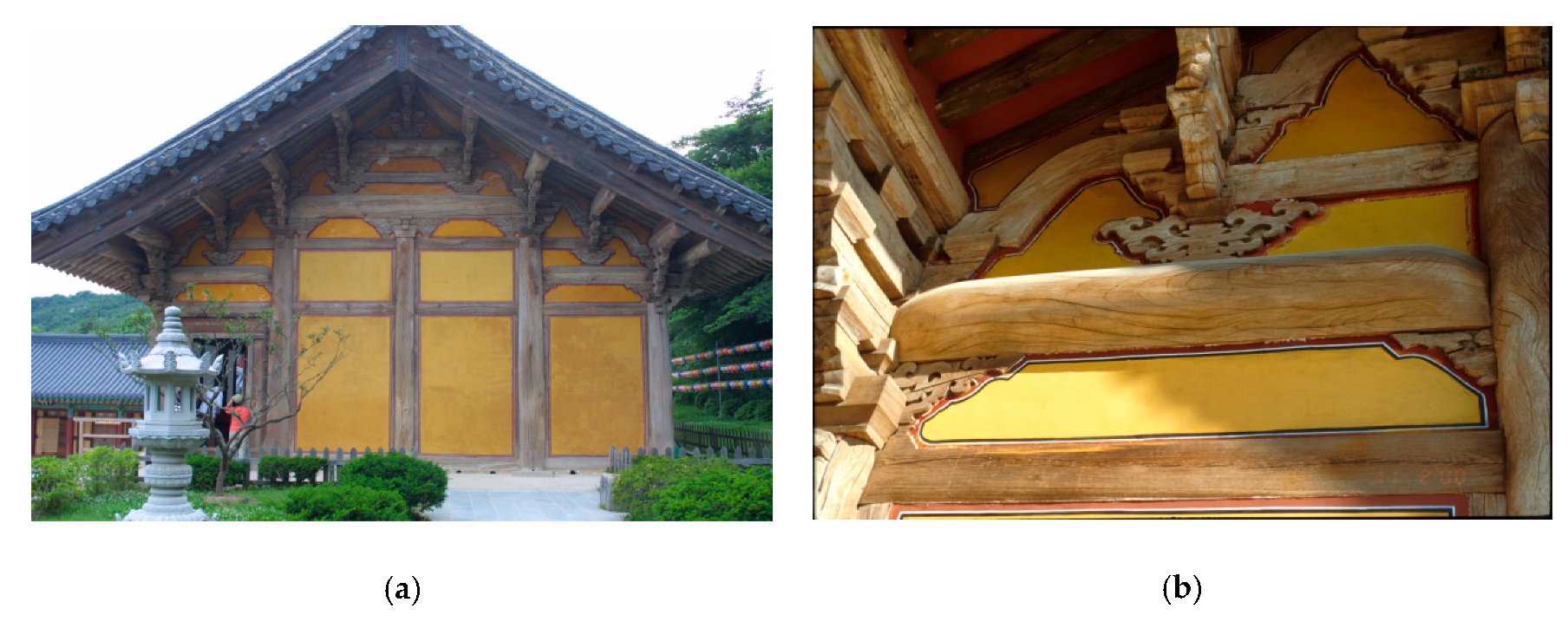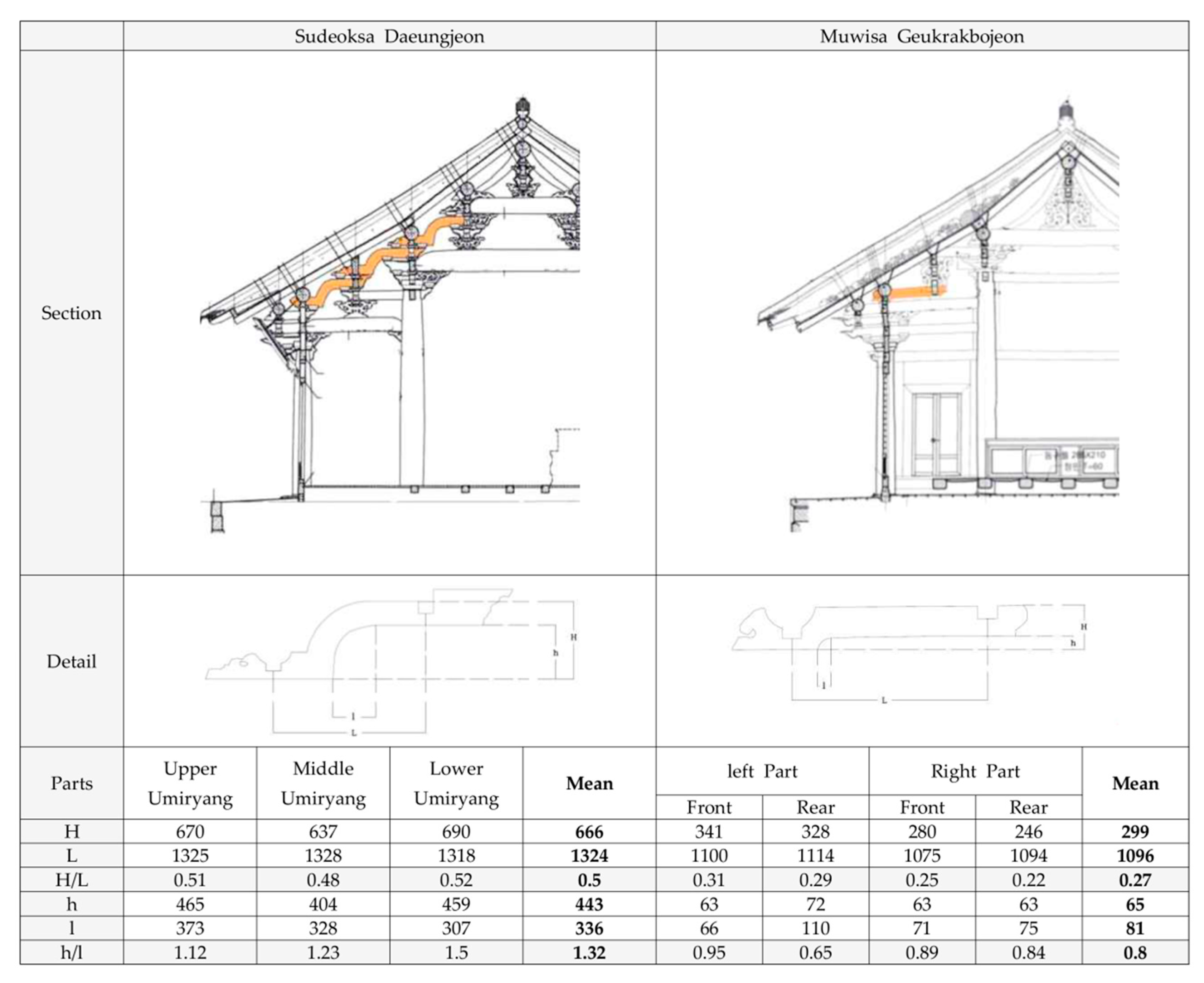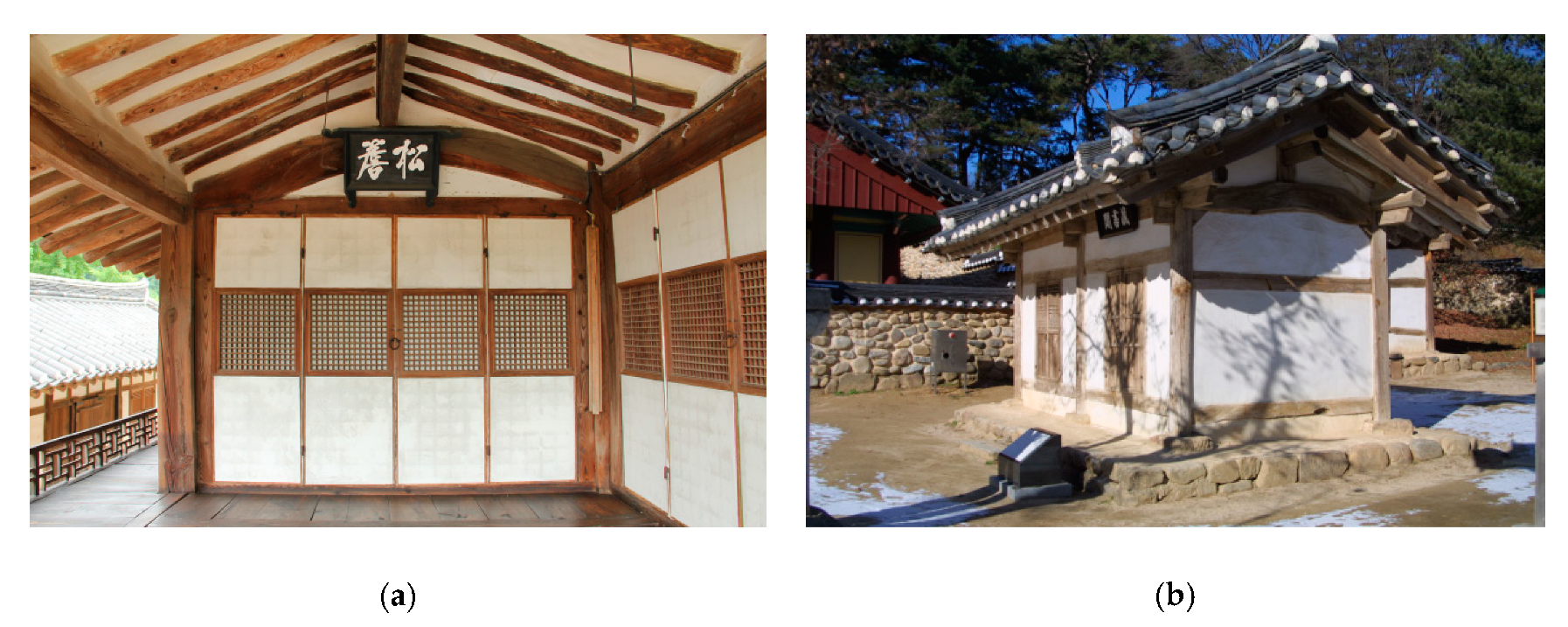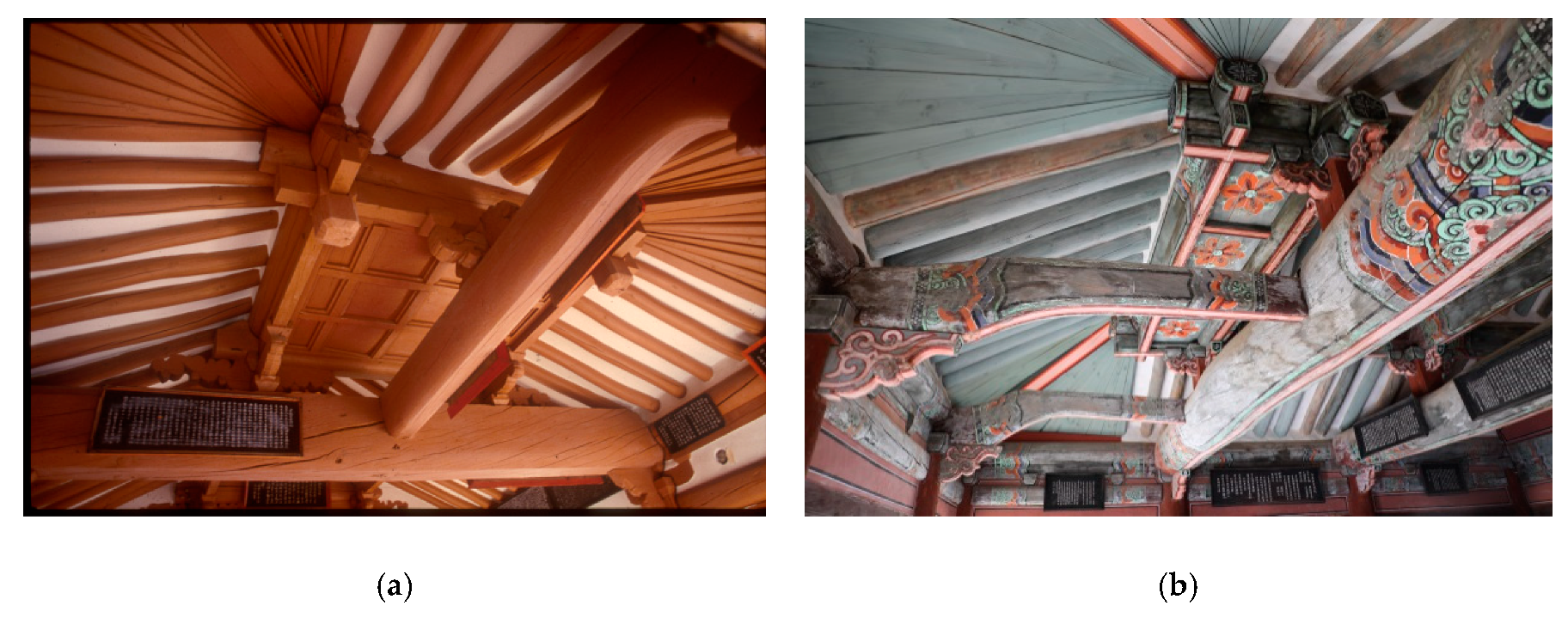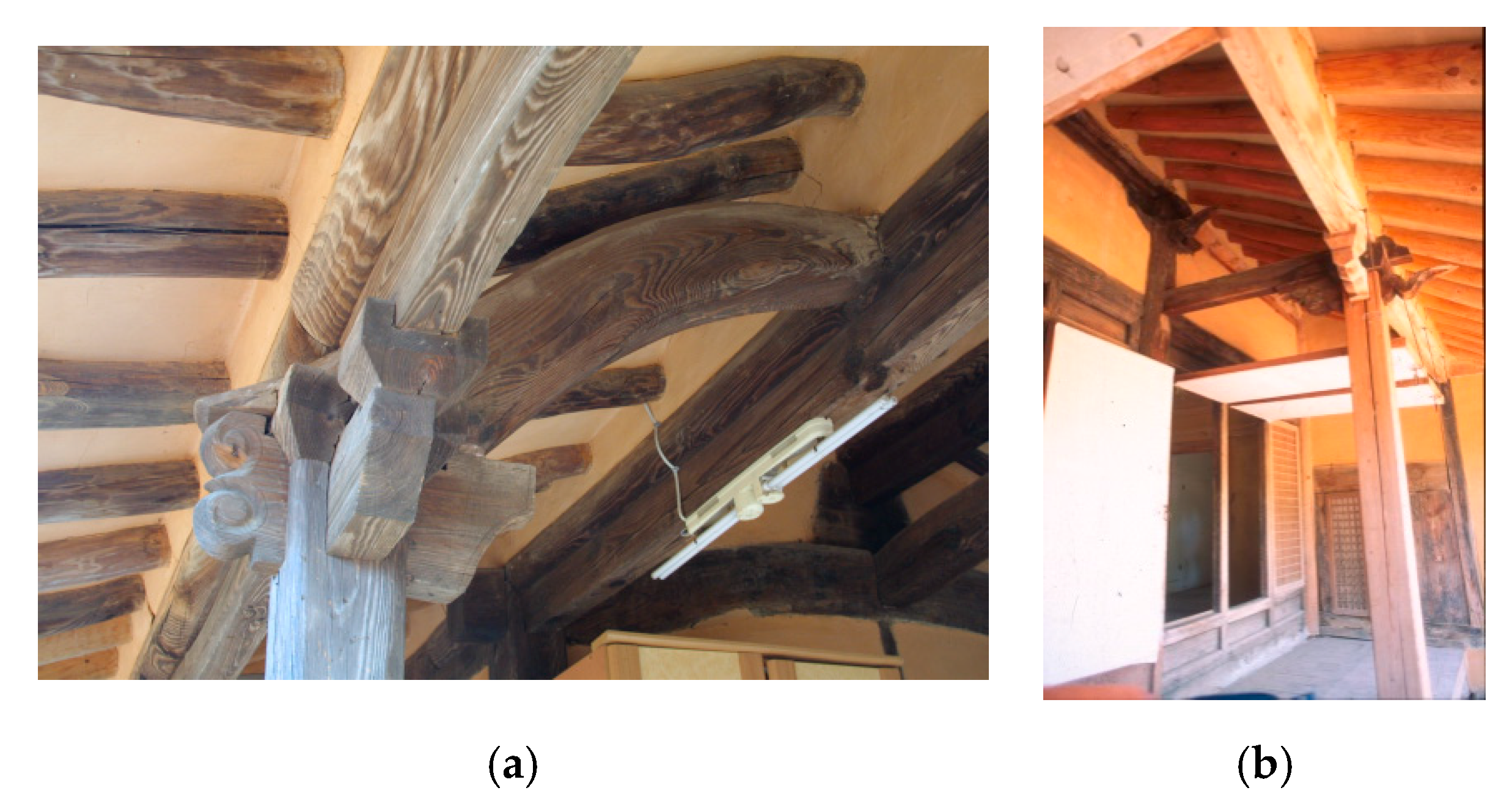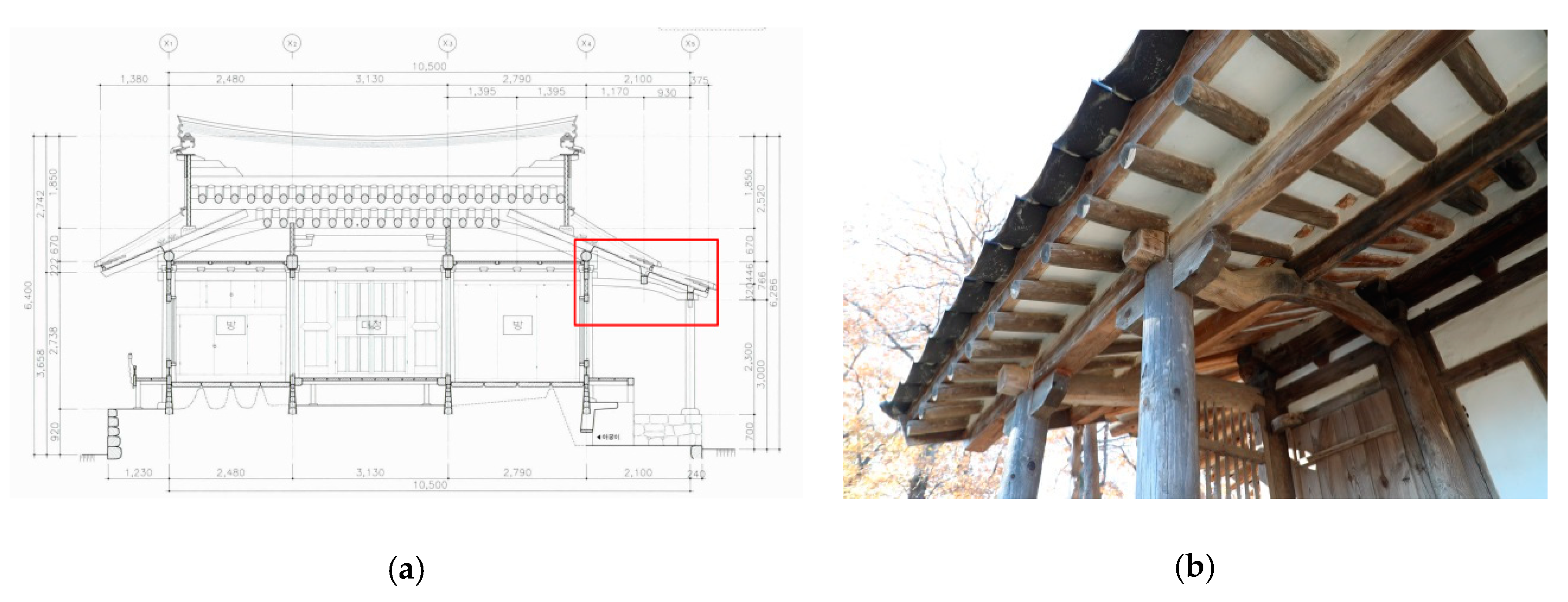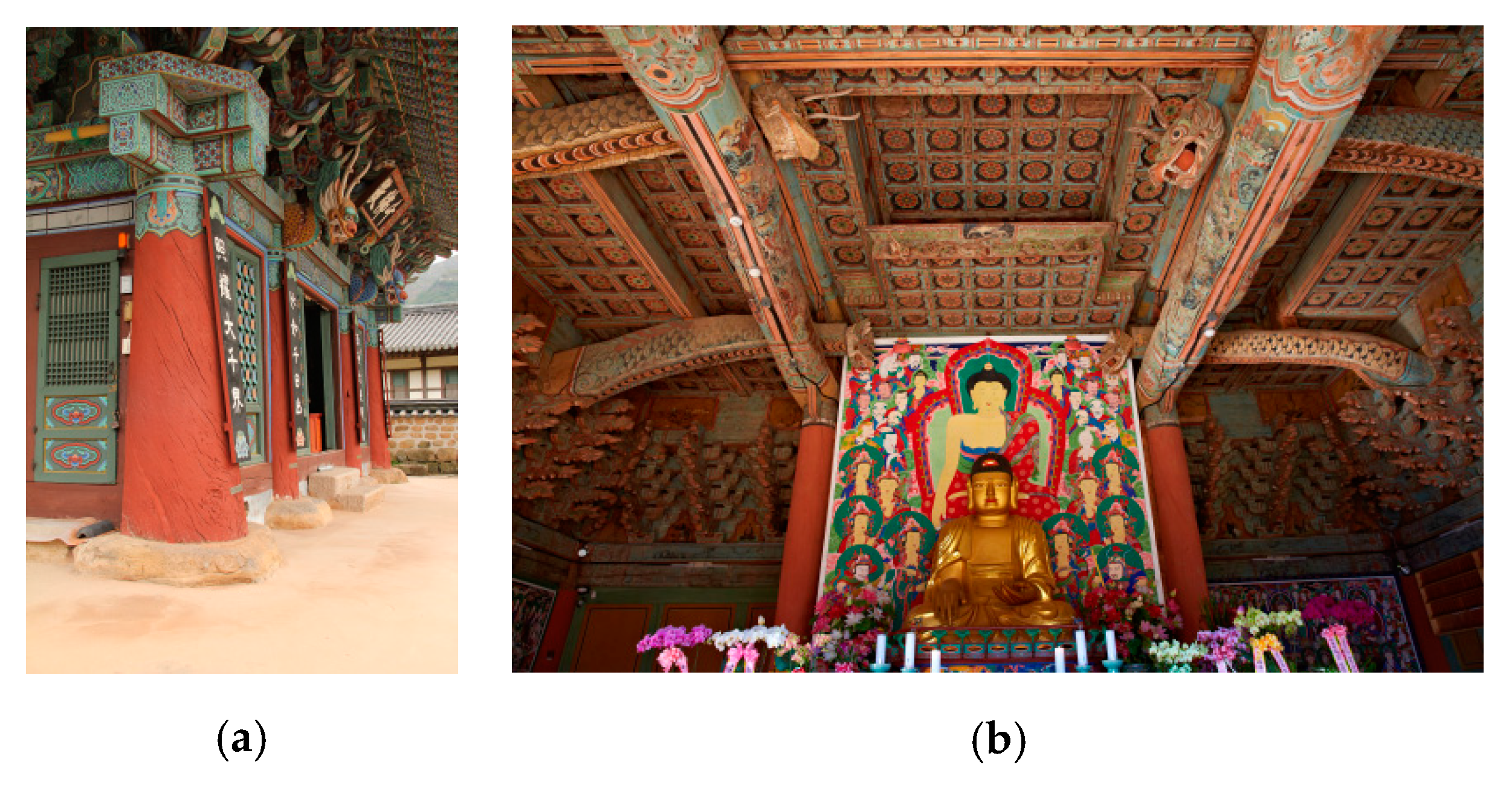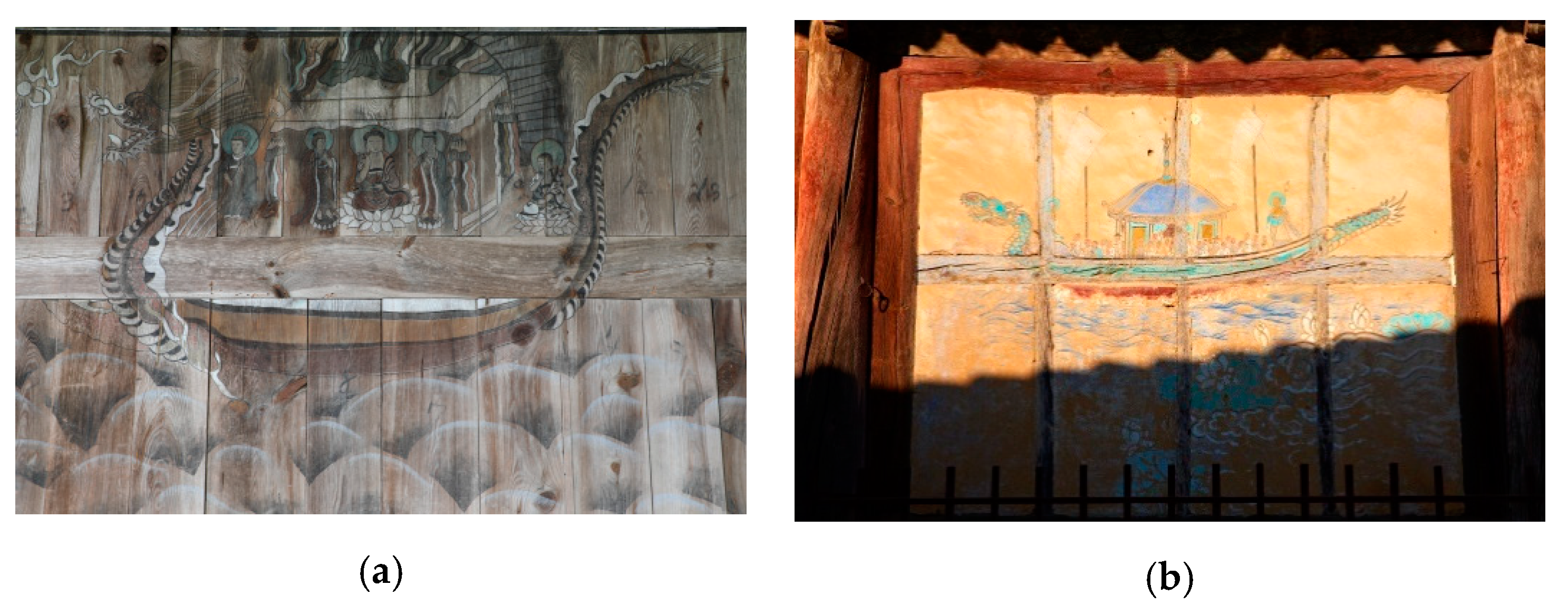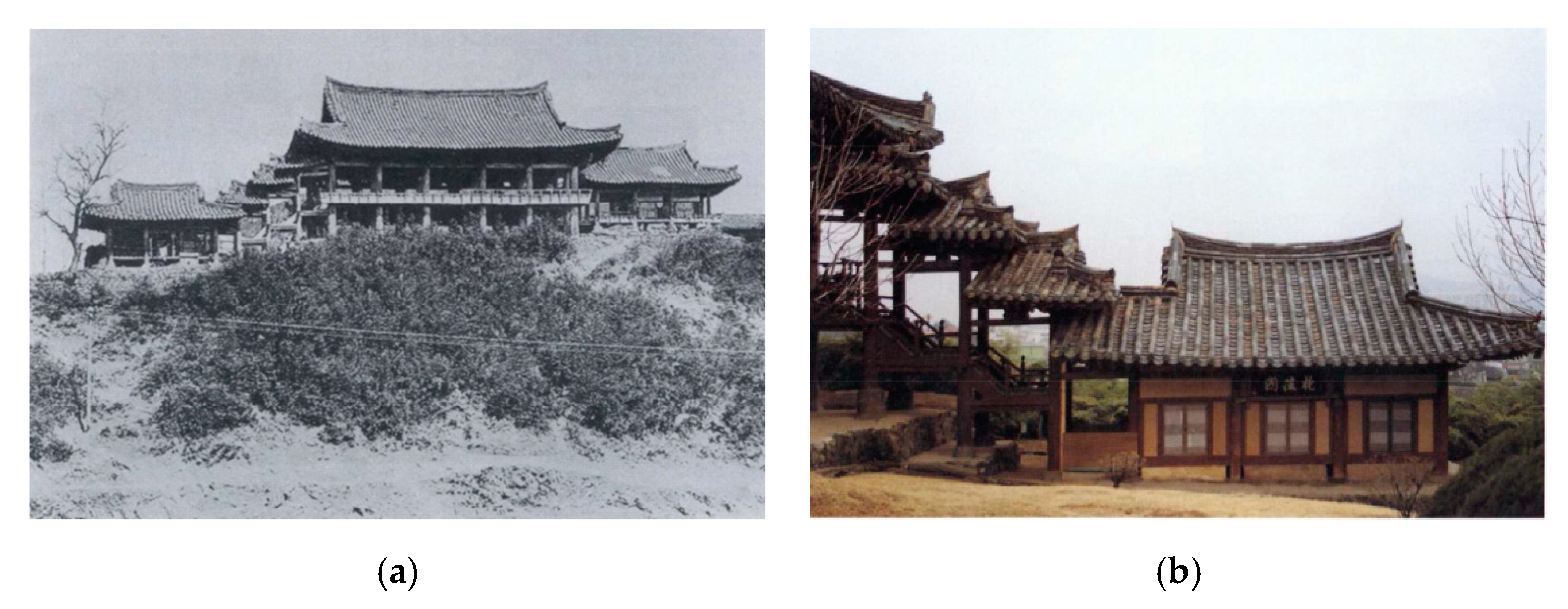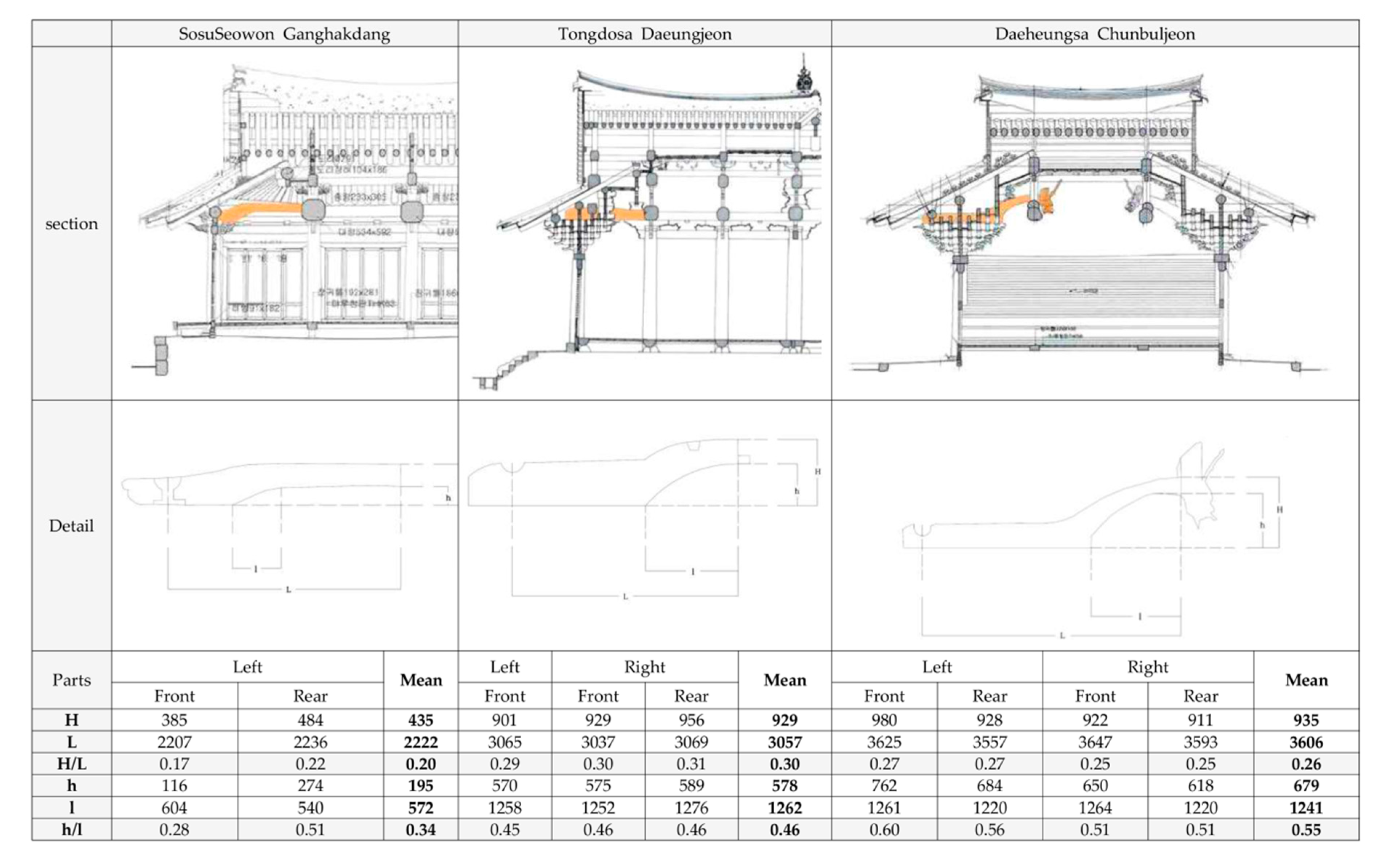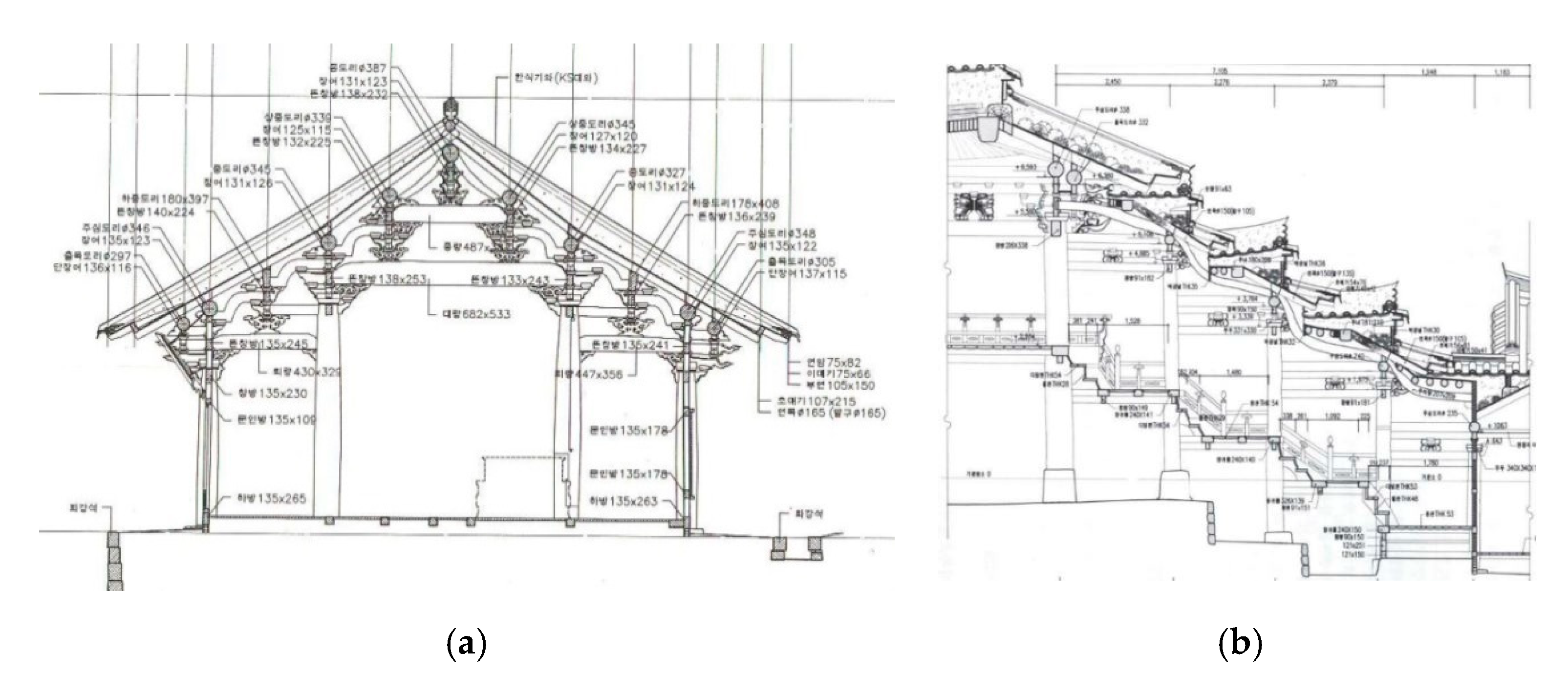4.1. Early Joseon Dynasty (1392–1592): The Restrained and Weakened Curvature
There are notable wooden buildings of the early Joseon Dynasty including Bongjeongsa Daeungjeon, Gaesimsa Daeungjeon, Muwisa Geukrakjeon, Gwanryongsa Yaksajeon, Songgwangsa Guksajeon, and Songgwangsa Hasadang and Sungryemun in Hanyang, which was the capital at the time. In addition, there are a number of wooden buildings of the early Joseon Dynasty still remaining in some culturally preserved villages.
Compared to the architecture of the Goryeo Dynasty, the curves in architectural components of the early Joseon period can be described by two trends: the weakening of the curvature and a curve close to a straight line.
For example, the Baeheulim pattern, one of the most representative features of the Goryeo era, became indistinct in the buildings of this period. It tended to be visually unapparent even if it was applied. However, there are many columns that gradually become narrower from the bottom to the top. This type of column is called a “Minheulim” column.
Additionally, Umiryang, which had been used in the Goryeo Dynasty, was also applied to the wooden architecture of the early Joseon Dynasty. With regard to temple architecture, Gwanryongsa Yaksajeon, Gaesimsa Daeungjeon, and Dogapsa Haetalmun are among the well-known Buddhist temples with Umiryangs installed in the early Joseon era. Except for the temple buildings, Jeonjugaeksa Jungchung, a government building in the city of Jeonju, shows how an Umiryang looked at the time. Compared with the Umiryang of the Goryeo Dynasty, the curvature of this Umiryang, in terms of the ratio of the width to the length of the curve, became less steep and weakened in the Joseon Dynasty (
Figure 6).
Comparing the section between Sudeoksa Daeungjeon of the Goryeo Dynasty and Muwisa Geukrakbojeon of the early Joseon Dynasty [
14], there is a clear distinction of the curved wooden member, Umiryang. When it comes to the height proportion of the member, the height becomes much lower than the member length from Goryeo to the early Joseon. The proportion, H/L, can be seen from
Figure 6: 0.5 to 0.27. From the point of the curvature, both h and l are getting smaller. If both height distances were lowered equally, there would be no change in H/L. As a result, although the curved wooden member is still used from the Goryeo Dynasty to the early Joseon Dynasty, the deliberate formative curve of the Goryeo Dynasty is clearly reduced in the Confucian society of the Joseon Dynasty.
Muwisa Geukrakjeon has drawn attention for its architectural qualities of the time responding to the changes of the Umiryang. The crossbeams show different shapes from one another based on the columns’ position supporting them, and Daedeulbo (a crossbeam or girder) of the largest diameter was installed in the center. However, Toetbo, a kind of thinner crossbeam, was used on the side of the building, and the Umiryang was placed on the top of the Toetbo. As the result, the combined height of the Toetbo and the Umiryang is equal to the Daedeulbo. Based on these changes, we can predict that future architectural works will use a Daedeulbo with a larger diameter, and the Umiryang will become obsolete.
The weakening of the curve is also because the size of the building was reduced and the number of components used to make the building decreased. As a result, the cost and effort invested in the building were reduced.
In addition, the kings and the leaders of the Joseon Dynasty suppressed Buddhism. It was impossible to officially become a monk, and the benefits of applying to temples disappeared. Therefore, it was impossible to build new buildings on a large scale, and it was not easy to repair and maintain existing buildings [
2].
Compared to the time when Buddhism was suppressed, the Joseon Dynasty’s national ideology was Neo-Confucianism, where leaders of Confucianism valued the practice of moderation and a frugal lifestyle. This idea was well reflected in the architecture. The representative buildings were their houses and other educational facilities such as Seowon. The curved building components, Daedeulbo and Chungryang, a perpendicular beam to the Daedeulbo, can also be seen in the houses and the Seowon building.
Daedeulbo is a very important component of East Asian wooden architecture that connects the front and rear columns, regardless of the size and type of building. Therefore, it is essential even in small-scale buildings and houses. The smallest and simplest structure, “3Ryang-jip”, is basically two columns supporting a crossbeam, and a short column called Daegong is placed on the crossbeam holding a gable roof (
Figure 7b). Several houses of the early Joseon Dynasty, such as Songcheomjongtaek, Gwangajeong, Hyangdan, and Muchumdang were built using very simple structures that have been well preserved, especially in Yangdong village [
15,
16].
Since the distance between the front and rear columns is small and the building is not very tall, a convex-shaped timber is used for the girder (
Figure 6 left). This structure makes the ceiling of the indoor space look high and reduces the cost of construction. In spite of the small size of the building, there is a feeling of openness. This kind of structure supports the guiding principles of Joseon Dynasty architecture: restrained simplicity while considering functionality.
There is a saying “Gumibulu” in Korean to describe this kind of aesthetic, which translates to “looking frugal but not shabby”. Similar to Gumibulu, there is also “Hwaibulchi”, meaning “looking splendid but not extravagant”.
Chungryang, the perpendicular beam to Daedeulbo, is a common component that is used in traditional Korean architecture to make “Palchakchibung”, which is a type of half-hipped roof in the wooden buildings of Joseon. Chungryang is connected to the Daedeulbo at a right angle and is a unique structural feature of the Korean wooden architecture. Ojukheon [
17] and Haeunjeong [
18] in the city of Gangneung are among the representative cases installed with Chungryang in the early Joseon Dynasty. The length of a Chungryang is 1 Gan (about 3 m), and the shape is close to a straight line. In particular, the edge of the beam connected with the main girder is a straight line. However, on the opposite side, the joint part connected to the column was processed into a curved shape. Except for residences, Chungryang is also found in Seowon, which is a private educational institution of the Joseon Dynasty. SosuSeowon [
19] is the first Seowon in Korea, revealing that the layout of the building at that time was not yet formally set up. In the Seowon, there is a building called Ganghakdang (lecture room), which was built at the time [
20]. Myongryundang has Palchakchibung, just like Ojukheon and Haeunjeong in Gangneung, and thus Chungryangs were installed at a right angle to the Daedeulbo (
Figure 8). The Chungryang appears to be almost a straight line. From a profile view, the bottom part is shaped as a curved line toward the point connecting the columns, while the top part of the Chungryang looks like a straight line.
Among the representative buildings of the Joseon Dynasty, the philosophy and ideas of Neo-Confucian scholars are well reflected. As such, there are historians who contend that the role of architects in the Joseon Dynasty can be seen as Confucian scholars [
21]. A notable example of this argument is from Lee Hwang of the early Joseon Dynasty, who built Dosan Seodang, which reflects his taste for a frugal lifestyle suitable for a scholar [
22].
4.2. Mid-Joseon Dynasty (1592–1800): Application of Naturally Curved Timber
Between the end of the 16th century and the first half of the 17th century, massive international wars took place during the Joseon Dynasty. Hence, Joseon found itself in its worst situation economically and socially. Two wars, Imjinwaeran, the Japanese Invasion between 1592 and 1598, and Byongjahoran, the Manchu war from 1636 to 1637, were among the most well-known ones. The complex social circumstances including a reduced population, restoration from the destruction of the wars, and challenging foreign relations were reflected in the architecture as well. Nevertheless, there were some positive aspects of these difficulties. In the process of overcoming the physical and mental damage, Korean society gained a new perspective, adopting more rational and pragmatic thinking and rejecting old customs, and this social trend was also reflected in architecture. While the nation’s power had been weakened by the war, on the contrary, Korea’s unique techniques had been developed and incorporated in the formative arts and architecture [
23].
For example, the Toetbo beam was a widely used component of Korean housing construction because of its many advantages. Among them, a special case can be found in Dorae village in the city of Naju, which is one of the representative historic villages of the mid-Joseon Dynasty. The oldest building in the village is Unamgotaek Sarangchae, which was constructed in 1732 [
24]. This building has a unique feature in the layout of the columns. In general, columns of a wooden building are placed, aligning lines from the front and rear as well as the left and right. However, in the Unamgotaek Sarangchae, the columns are not arranged on an orthogonal grid if comparing right and left columns. From the right, two columns do not match the one on the front and the other on the side.
To create such a plan, a different structure needed to be applied. Generally, a crossbeam connects two columns directly. However, if the row of the columns is not aligned in a straight line, it is impossible to install a horizontal beam between the columns. Therefore, one side was connected to the column, and the other side where there was no column was connected to a purlin at a higher level. Due to the level difference, the crossbeam had to be bent, and thus was made of naturally curved timber (
Figure 9a).
It is possible to speculate why the conventional column arrangement was not used in that period. First, a visual effect can be created where the floor would look larger if viewing the building from the front. At present, the front of the Daechung appears to be two bays long. If the column had been positioned normally, the front of the Daechung would be appeared to be 1.5 bays. Actually, the front bay of the Daechung was seen as a symbol of the social status of the homeowner in Korea. Homeowners generally thought three bays were the ideal modules for the Daechung in order to show the dignity of the house.
Second, this arrangement helps enlarge the vertical indoor space. If the columns are aligned in a straight row, there needs to be a horizontally straight crossbeam to connect them, and its level would be lower than the current convex one. As a result, it would be impossible or uncomfortable for a person to stand and pass under the beam. In addition, a regular alignment of the columns lines would result in a smaller area from the edges of the Daechung, leading to a poor use of space.
The current plan of Unamgotaek resulted from considering the size of the elevation view of the floor and the use of space. This type of plan was enabled by the use of naturally curved timber. Carpenters at that time strove to find such timbers in nature.
The extended Toetbo beam was also used for shade. On the opposite side, to the east of Korea, and east of Naju in Jeonlanamdo, there is a city called Yeongcheon in Gyongsangbukdo where the Sunwondong village is located. In that village, there is a housing site called Yeonjunggotaek that has been listed as a nationally designated cultural asset [
25]. It is composed of a main house and a pavilion. In this paper, the Yeonjung pavilion is discussed in terms of the use of curved timbers, since the ideas applied to maximize the building’s function are very unique.
The original structure of Yeonjung was a simple “3Ryang-jip” style. The roof was composed only of rafters, creating short eaves. If the eaves are short, the structure is vulnerable to rainfall as well as wind or strong sunlight. Therefore, the rafters of Yeonjung were extended with a Buyeon. If the building had followed the original plan, it could have been installed without another column. However, because it was enlarged, the columns had to be built up outside in order to hang the Buyeon as an extension of the roof. Since there was a height difference between the existing and new columns, a bent connecting beam had to be used. In this way, the roof provided proper protection against rainstorms and sunlight as an awning. Therefore, naturally curved timbers became a very useful building material sought after by carpenters (
Figure 10).
There are some distinctive features when comparing the wooden buildings in historic villages between the early and mid-Joseon eras. Those in mid-Joseon used curved timbers in more diverse positions, while the curved timbers in early Joseon were not frequently used for girders.
In Unamgotaek Sarangchae, curved timbers were applied to columns and purlins. The use of curved timber enlarged the front view and heightened the indoor space. In Yeonjunggotaek’s pavilion, curved timbers were used to extend the eaves and to create a unique awning. All these practical solutions resulted from the carpenters’ ideas, which corresponded with the philosophy and attitude of “Gyongsaechiyong” in Silhak (the Realist School of Confucianism). The incorporation of Silhak ideas in architecture can be seen when Jeong Yakyong built a new city called Hwasung with the support of King Jeong-Jo at the end of the 18th century. However, the signs that practical ideas would be reflected in architecture were already appearing in the mid-17th century. Yoo Hyongwon, one of the pioneering Silhak scholars, argued in his book Bangyesurok that it was time to change the functions of traditional cities [
3].
4.3. Late Joseon Dynasty (1800–1910): Symbolic and Creative Use of Naturally Curved Timber
In the late Joseon period, a representative characteristic is the increased use of decorations in the building, especially featuring dragons. In the architectural style called Dapo, a building component called Anchogong is constructed on the top of the building columns. It originally looked very simple in the palace building where Anchogong was used for the first time. It was the Daeungjeon of the Yosu Heungguksa built in 1690 that started to engrave the dragon in Anchogong [
26]. Another example is Yosu Jinnamgwan built in 1718, which was an army training facility. Interestingly, both are located in Yosu, which is a harbor city. Thus, the navy was stationed there and had a military unit consisting of Buddhist monks at that time. The Anchogongs in the palace buildings did not have sculpted dragon features. The Anchogongs with engraved dragons were found only in the temple buildings, except for those in Jinnamgwan (
Figure 11a).
A dragon sculpture of the Anchogong seen in the front of the temple building has made the Buddhist temple itself a Banyayongsun, meaning a dragon-propelled boat to Geukrakjeongto, the Buddhist paradise. There was a notion that regarded the temple building as the boat to paradise, which influenced the dragon decoration on the top of the columns [
27]. There are also some temples whose murals included paintings of dragon boats (
Figure 12).
As previously mentioned, Chungryang is one of the architectural structural elements used since the early Joseon Dynasty. However, inside the main building of the Buddhist temple, the ornament of the dragon sculpture began to be used as an Anchogong of the pillar. It is in the same position and functions as the Chungryang from the early Joseon houses or Seowon buildings. However, although there was no decoration and it was created to be straight in the early Joseon period, the head of a Chungryang in the late Joseon was sculpted with a dragon head. Dragon sculptures that appeared in the late 17th and early 18th centuries were also used indoors.
The first place where Chungryangs carved with dragons were used was Yosu Jinnamgwan [
28]. Since then, Chungryangs decorated with dragon sculptures were widely used in Buddhist temples [
29]. The first temple was Hwasung Yongjusa Daeungbojeon where dragon sculptures were used in only two of the four Chungryangs located at the front. In large buildings, four Chungryangs were usually used in the front, rear, left, and right. In the temple of Seonamsa built in 1824, four dragons are positioned onto four Chungryangs (
Figure 11b).
The Chungryang in the late Joseon Dynasty tended to use bent timber as its natural shape, compared to the Chungryang of the early Joseon era. As discussed above, the Chungryang of the early Joseon dynasty was constructed in a relatively straight line. In addition, the Chungryang of this time was relatively thinner, and the head of the Chungryang did not protrude from the Daedeulbo, the girder. The Chungryangs in the late Joseon Dynasty used natural timber almost without processing, which was suitable to express the dynamic shape of a wiggling dragon. Additionally, dragon scales were painted on the body of Chungryang.
The following conclusions can be drawn by synthesizing what was discussed earlier. First, the dragon decorations in the building are likely to have been started by Buddhist monks. Second, the dragon decorations used in government offices or main buildings of palaces were symbols of authority, but the dragon decorations in the temple’s main building have come to represent a concrete image of a dragon-drawn ship.
In addition to the temple buildings, there is another example of the symbolism of the architecture in the late Joseon era. Milyang Yongnamru built in 1844 was one of the large pavilions belonging to a local government accommodation facility, a Gaeksa. The Gaeksa housed Jeonpae, a tablet with the word Jŏn, which was kept as an emblem of the king’s presence, and people pledged allegiance to the king. This building was also used as a guest house for government officials who visited from the central government in Seoul. Therefore, Yongnamru, the pavilion belonging to the guest house, was mainly used as a recreational spot for the officials to enjoy the surrounding scenery and to relax while writing poetry.
Yongnamru is composed of three buildings. There is the main building in the center, Neungpagak at a higher place on the left, and Chimryugak at a lower place on the right. The word “Chimryu” in Chimryugak is the abbreviation of Suseokchimryu, which is a metaphorical expression meaning “soothing the weary body and mind in nature”. In addition, the literal meaning of Chimryu is “a pillow on the water” or “to use water as a pillow”. If a person lies down on the Chimryugak, there must be water below the person’s head as a metaphor. In addition, the water in the main building at the higher location needs to flow down to Chimryugak. In order to complete this metaphoric image of falling water, a staircase-shaped corridor was built between the two buildings [
30]. Naturally curved timber was used to create the staircase-shaped building. This wood was also used for the stairs. The architect of Yongnamru in 1844 intended to show the meaning of Chimryu by means of shaping the building as a cascade of stairs (
Figure 13).
As a result of examining the buildings built in the late Joseon Dynasty, the tendency to use curved timbers is clear. First, in temple architecture, curved timbers were used for Chungryangs. It was the same Chungryang as used in other times, but they were thinner and in a relatively straight form in the early Joseon buildings. However, in the late Joseon dynasty, the naturally curved timbers for Chungryang were used to express wiggling dragons in the temple architecture. The dragon symbolized a strong presence in charge of defending people accompanied by Buddha, a leading figure to defeat bad energy. The dragon sculptures originated from the exterior of buildings, but later the use increased, eventually expanding into the interior as well. The temple building decorated with the dragon figures represented Banyayongsun, the dragon boat to paradise.
In addition, curved timbers in a government building were used to create a staircase building. In order to connect the upper and lower levels of buildings, a staircase was placed in the middle, symbolizing the gathering of water falling from a high place to a low place. Moreover, the structure symbolizes Chimryu, a person lying down and resting on water. In the late Joseon period, the bent wooden structure is expanded to give meaning beyond the function compared with the functional use of the bent wood. In contrast to the architecture in the mid-Joseon period when the curved timbers were used just functionally, the use of those in the late Joseon era gave symbolic and metaphoric meanings to the buildings.
